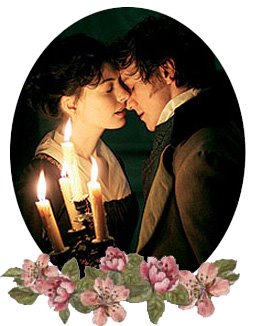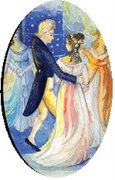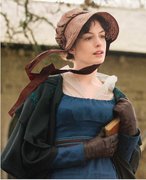 Following the afternoon post about Robin Adair in Emma, I thank Jane Odiwe for providing us a very interesting historical perspective of Robin Adair, taken from the scanned pages of an old book titled ‘Stories of Famous Songs Vol. 1’ by S. J. Adair Fitz Gerald (circa 1901). Those who are interested in this book might be able to explore it in the Traditional Music UK or the Google Book (Michelle? Wink, wink!).
Following the afternoon post about Robin Adair in Emma, I thank Jane Odiwe for providing us a very interesting historical perspective of Robin Adair, taken from the scanned pages of an old book titled ‘Stories of Famous Songs Vol. 1’ by S. J. Adair Fitz Gerald (circa 1901). Those who are interested in this book might be able to explore it in the Traditional Music UK or the Google Book (Michelle? Wink, wink!).
There were debates whether Robin Adair was originally an Irish song or a Scottish song. The six-pages article, however, suggested that Robin Adair was indeed an Irish song about a young Irish medical doctor named Robin Adair, and that he song was written by a Lady Caroline Keppel circa 1750. But beforehand, the song was preceded by another song called ‘Eileen Aroon’ (Ellen, the treasure of my heart), from where Robin Adair borrowed the melody. Eileen may be based on a real person as well, and this is the story of Eileen Aroon from Fitz Gerald’s book.
Carol O'Daly, commonly called " Mac Caomh Insi Cneamha," brother to Donogh More O'Daly, a man of much consequence in Connaught, was one of the most accomplished gentlemen of his time, and particularly excelled in poetry and music. He paid his addresses to Eileen, or Ellen as we should say now, the daughter of a Chieftain named Kavanagh; she was a lovely and amiable young lady who returned his affection, but her friends disapproved of the connection, for, it is believed, political reasons. Carol O'Daly was obliged to leave the country for a time, and her family availed themselves of the opportunity, which his absence afforded, of imposing upon Eileen a belief in his (supposed) faithlessness, and of his having gone to be married to another; and after some time they prevailed upon her to consent to marry a rival of O'Daly's. The day was fixed for the nuptials, but O'Daly returned the evening before. Under the first influence of his disappointment, he sought a wild sequestered spot on the sea-shore, and inspired by love, composed the song of “Eileen Aroon." Disguised as a harper he gained access among the crowd that thronged to the wedding. It happened that he was called by Eileen herself to play and sing. It was then touching the harp with all the pathetic sensibility which the interesting and dramatic occasion incited, he infused his own feelings into the song he had composed, and breathed into his “softened strain" the very soul of plaintive melody. In the first stanza he intimates, according to Irish idiom, that he would walk with her, that is, be her partner for life, or constant lover for life. In the second, that he would entertain, and afford her every delight; and then he continues:
" Then wilt thou come away? Eileen a Roon ! O wilt thou come or stay ? Eileen a Roon."
She soon felt the power of his eloquent plead-and answered, by signs, in the affirmative, having long recognized him. Then he bursts out rapturously;
" Cead mille failte ! Eileen a Roon! Cead mille failte ! Eileen a Roon."
And still with more welcomes and ecstasies he greets her, and to reward his fidelity, she contrives to elope with him that same night—the night before the intended marriage with his rival, and of course they lived happily ever after.
Aawww…. That’s sweet… Now, we go to the lad named Robin Adair. This is an excerpt from Fitz Gerald’s book:
 About a century and a half ago, an impulsive young Irishman named Robert Adair, who was studying in Dublin for the medical profession, got into some scrape, and as he possessed little money and few friends, the only way he saw out of the difficulty was flight. So he speedily quitted Dublin and made his way to Holyhead, with the intention of going to that golden city of ambitious youth, London. Post travelling in those days was very expensive, and when Adair reached Holyhead, he discovered that his purse was as light as his heart; consequently he had nothing to do but accept the inevitable, and so he manfully set out to walk to the metropolis. He had not gone far when he came upon a carriage that had been overturned, for the roads at that time were in a horrible condition. The owner and occupant of the vehicle a well-known leader of fashionable society, was greatly alarmed at the accident, and had besides, received some slight personal injury. Adair, like a true Irishman, at once offered his services, and in a very short space of time had the carriage righted, and the lady, carefully attended to. Adair was a very handsome and aristocratic young fellow, and notwithstanding that his dress might have been of finer texture and in better condition, he had a striking appearance. With ready frankness he soon explained that he was a surgeon, and begged permission to examine into the extent of the lady's injuries. An examination soon showed that they were of merely a trifling nature—that the nerves were more upset than the body hurt. Adair then took the opportunity to explain that he was on his way to London to endeavour to make a name in the profession he had chosen, and as the fair lady was still apprehensive of unknown dangers, and still felt the effect of the shock, she offered the vivacious young Irishman seat in her carriage as a protector, for she herself was travelling to the metropolis when the accident occurred. He was only too delighted to accept the proffered kindness, and very soon restored his travelling companion to health and good spirits. Arrived in London she presented him with a hundred guineas, and invited him to come to her house as often as he pleased.
About a century and a half ago, an impulsive young Irishman named Robert Adair, who was studying in Dublin for the medical profession, got into some scrape, and as he possessed little money and few friends, the only way he saw out of the difficulty was flight. So he speedily quitted Dublin and made his way to Holyhead, with the intention of going to that golden city of ambitious youth, London. Post travelling in those days was very expensive, and when Adair reached Holyhead, he discovered that his purse was as light as his heart; consequently he had nothing to do but accept the inevitable, and so he manfully set out to walk to the metropolis. He had not gone far when he came upon a carriage that had been overturned, for the roads at that time were in a horrible condition. The owner and occupant of the vehicle a well-known leader of fashionable society, was greatly alarmed at the accident, and had besides, received some slight personal injury. Adair, like a true Irishman, at once offered his services, and in a very short space of time had the carriage righted, and the lady, carefully attended to. Adair was a very handsome and aristocratic young fellow, and notwithstanding that his dress might have been of finer texture and in better condition, he had a striking appearance. With ready frankness he soon explained that he was a surgeon, and begged permission to examine into the extent of the lady's injuries. An examination soon showed that they were of merely a trifling nature—that the nerves were more upset than the body hurt. Adair then took the opportunity to explain that he was on his way to London to endeavour to make a name in the profession he had chosen, and as the fair lady was still apprehensive of unknown dangers, and still felt the effect of the shock, she offered the vivacious young Irishman seat in her carriage as a protector, for she herself was travelling to the metropolis when the accident occurred. He was only too delighted to accept the proffered kindness, and very soon restored his travelling companion to health and good spirits. Arrived in London she presented him with a hundred guineas, and invited him to come to her house as often as he pleased.
Robin Adair was a wise and energetic young man, and took full advantage of the lucky turn in his fortunes to study assiduously, and soon, with the assistance of his patroness, acquired a good connection in the best end of the town. He was frequently at the dances given by this lady and others, he being a graceful dancer, a good conversationalist, and a man of considerable natural ability. One night, at a party, he found that his partner was Lady Caroline Keppel, the second daughter of the Earl of Albemarle. It was a case of love at first sight —mutual love; and Lady Caroline's attachment was as sincere as it was sudden; they were the observed of all the guests; and after a few meetings the relations were in despair. The young couple, however, continued to meet again and again, and their affection ripened into an intense passion. Her kinsfolk were stupefied with amazement. Were they to allow an unknown Irishman to carry off the flower of their flock, the beautiful Caroline? They set their wits to work to try and persuade her to give him up. But all in vain. Handsome heirs of the oldest and stiffest families were prevailed upon to woo her, but she would not listen to them. She was sent abroad to see if travel would alter her determination and cure her "folly," but without avail, and gradually she fell ill.

When she was at Bath for the benefit of her health, she wrote the verses now so popular, and adapted them to the melody of "Eileen Aroon," which Robin Adair had doubtless often sung to her. At last the separation from Adair and the importunities of her relatives caused her to become so dangerously ill, that, upon the doctors despairing of her life, and seeing the disease was more of the heart and mind than of the flesh, the union of the faithful pair was consented to.
The event was duly notified in the "Grand Magazine of Universal Intelligence" thus: "February 22nd, 1758, Robert Adair, Esq., to the Right Honourable the Lady Caroline Keppel." This was the culminating point in the pretty love story.
Lovely story, eh? Hmm…Adair helping the gentleman in the carriage reminds me of Jane Austen’s Sanditon. Or Willoughby attending to Marianne’s leg. Anyway, I could not help saying that Lady Caroline and Robin Adair (and Eileen and O’Daly for that matter) were a lucky couple. Sadly, it was not the case for Jane Austen and Tom Lefroy.
Pic 1: The Lovers, by Pierre-Auguste Renoir
Pic 2: Romeo and Juliet, 1884, by Frank Dicksee
Pic 3: The Brahms Waltz, 1923, by Robert McGill Mackall
 Following the afternoon post about Robin Adair in Emma, I thank Jane Odiwe for providing us a very interesting historical perspective of Robin Adair, taken from the scanned pages of an old book titled ‘Stories of Famous Songs Vol. 1’ by S. J. Adair Fitz Gerald (circa 1901). Those who are interested in this book might be able to explore it in the Traditional Music UK or the Google Book (Michelle? Wink, wink!).
Following the afternoon post about Robin Adair in Emma, I thank Jane Odiwe for providing us a very interesting historical perspective of Robin Adair, taken from the scanned pages of an old book titled ‘Stories of Famous Songs Vol. 1’ by S. J. Adair Fitz Gerald (circa 1901). Those who are interested in this book might be able to explore it in the Traditional Music UK or the Google Book (Michelle? Wink, wink!). About a century and a half ago, an impulsive young Irishman named Robert Adair, who was studying in
About a century and a half ago, an impulsive young Irishman named Robert Adair, who was studying in 












































8 comments:
Yet another lovely post. I will read it in more depth once I get out of this hectic cafe! I will look into that book - always lovely to know more of the story/background of the music you play... And I am a sucker for Irish tunes. I'm still trying to find the song Emma/Frank sing in Kate Beckinsale's Emma, "It was early in the month of May," - I found the title of it the other day, and immediatley forgot it! :/
I was reading chapter 4 from Radovici's book last night. It is profoundly moving. It really affected me. I will be back later once I've re-read it several times.
PS: Would you recommend Parson Austen's Daughter? :)
Oh, yes, I would recommend Helen Ashton's book. It's a novel written a few years back (mine is the 1968 edition), so lots of things are uncovered now. But just to get a glance is nice. Her style is lovely as well, I smiled and laughed several times while reading.
I didn't remember the song between Emma and Frank in the Beckinsale Emma, but I love the song performed by Gwyneth Palthrow and Ewan McGregor ('Saw you not my Lady?'). The melody for that song was taken from one of JA's song books. The lyric is different, but the melody is the same.
Re: the song in Emma
There is some information about this song on the Emma (Beckinsale) message board at IMDB.
Thank you. I've checked the Emma (Beckinsale) MB in IMDB but could not find such reference. Can you post the link here please? Appreciate it.
http://www.imdb.com/title/tt0118308/board/nest/58302687
Ah, you didn't refer to the Robin Adair in particular, but 'just' the songs in Emma. Sorry, my mistake.
Yes, I've noticed that earlier. Thanks a lot for the tips.
https://m.imdb.com/title/tt0118308/soundtrack/
The above link didn’t work but using Google search (1996 Emma music) I found this link of IMDB has a list of all the 1996 Emma songs
Post a Comment